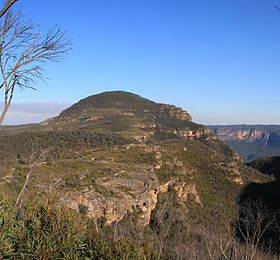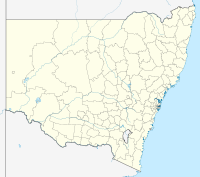- Mount Banks
-
Mount Banks 
Mount Banks in 2009Elevation 1,049 m (3,442 ft) [1] Location New South Wales, Australia Range Explorers Range Coordinates 33°35′19″S 150°22′16″E / 33.5886°S 150.3712°ECoordinates: 33°35′19″S 150°22′16″E / 33.5886°S 150.3712°E Mount Banks is a mountain in the Blue Mountains National Park, New South Wales, Australia. It is located approximately one hundred kilometres west of Sydney and eight kilometres from the nearest residential area, Mount Tomah.
Contents
Geography
Mount Banks is part of the Explorers Range, which is located along the northern escarpment of the Grose Valley in the Blue Mountains National Park. The Explorers Range starts at Bells Line of Road and extends for several kilometres along the edge of the Grose Valley. Mount Banks is the first noticeable peak along the range and is found about two kilometres from Bells Line of Road. It was named Mount Banks in 1804 by the explorer George Caley, who had worked for the botanist Sir Joseph Banks, and who was the first European to reach Mount Banks.[2]
The distinctive thing about Mount Banks is the way the terrain and vegetation change radically approaching the top of the mountain. For the first two-thirds of the walk, the terrain is the standard sandstone of the Sydney and Blue Mountains regions, with a thin, rough scrub. After this, however, there is a volcanic basalt plug[3] which gives rise to a richly vegetated environment with grass and a canopy. Views can be had on the lower slopes of the mountains but there is no view at the top, unless the walker edges down the slope towards the escarpment, at which point there are views of the Grose Valley.[4]
Description
An unsealed road goes from Bells line of Road to a picnic area about one kilometre along, where vehicular access comes to an end. From the picnic area, a walking track makes its way approximately one kilometre to the top of Mount Banks, where there is a trigonometric station (generally known as a trig). This is 1062 metres above sea level.[5] From this point on, there is a fire trail that follows the Explorers Range for several kilometres before terminating above Zobel Gully. According to the topographic map, there is an abandoned mine in Zobel Gully, but there is no track to it.[6]
Activities
The area is popular for bushwalking, with extensive views of the Grose Valley from the lower slopes of the mountain and from the fire trail where it goes close to Banks Wall, about a kilometre south of the mountain. Photography is also popular because of the extensive views. There is no authorised camp site in the area, although unauthorised camping has been known to occur at the picnic area.
References
- ^ "Mount Banks". bonzle.com. http://maps.bonzle.com/c/a?a=p&p=33133&cmd=sp. Retrieved 2010-12-25.
- ^ Blue Mountains Website: Retrieved 30th August 2008
- ^ How To See the Blue Mountains, Jim Smith (Second Back Row Press) 1986, p.33
- ^ Sydney and Blue Mountains Bushwalks, Neil Paton (Kangaroo Press) 2004, p.270
- ^ Mt Wilson Topographic Map, 8930-1N, Land and Property Information, New South Wales
- ^ Mt Wilson Topographic Map
Blue Mountains topics Towns, suburbs
& localitiesBell • Berambing • Bilpin • Blaxland • Blackheath • Bullaburra • Faulconbridge • Glenbrook • Hartley Vale • Hazelbrook • Katoomba • Kings Tableland • Lapstone • Lawson • Leura • Linden • Little Hartley • Medlow Bath • Megalong • Mount Irvine • Mount Riverview • Mount Tomah • Mount Victoria • Mount Wilson • North Katoomba • Shipley • Springwood • Sun Valley • Valley Heights • Warrimoo • Wentworth Falls • Winmalee • Woodford • Yellow Rock • Yosemite
Mountain peaks Mount Banks · Mount Bindo · Mount Boyce · Mount Hay · Mount Irvine · Mount Piddington · Mount Solitary · Mount Trickett · Mount Wilson · Mount York · Narrow Neck PlateauTourist attractions Valleys Waterfalls Wentworth FallsHistory National Parks Miscellaneous Categories:- Mountains of New South Wales
Wikimedia Foundation. 2010.

